What Is An Insect Hotel?
Insect hotels are winter lodgings for your backyard crawling and flying bugs. Usually made of found or upcycled materials around your yard, these hotels consist of different suites catered to each little bug’s preferred lodging taste. Most hotels are constructed with a strong protective frame of wood boards or pallets and are filled with a variety of bug-friendly materials like straw, cork, sticks, or pinecones.
Why Build An Insect Hotel?
Insect hotels provide safe areas for solitary insects to hibernate over winter. Big lawns and the lack of dead wood in our yards leaves wild bees, spiders, and ladybugs without a place to live. Building accommodations for beneficial insects like ladybugs or flying pollinators can help benefit both your environment and your garden in the spring.
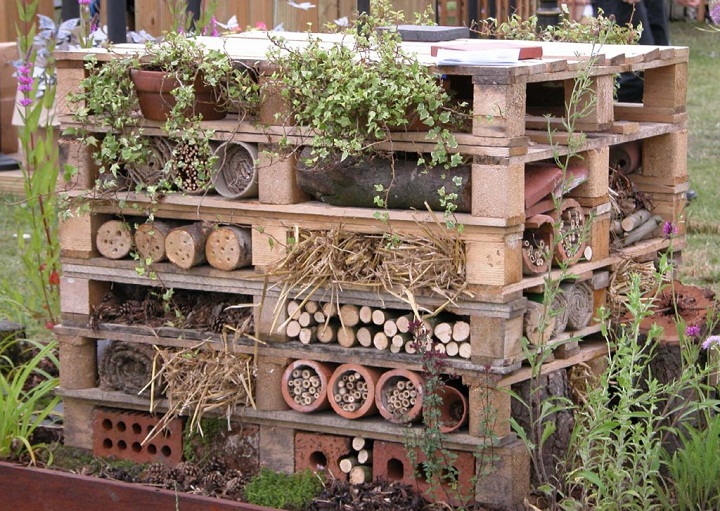
A wildlife stack can harbor numerous beneficial insects and amphibians. This habitat was made up entirely of recycled materials, the support is made up of old pallets. Image copyright: Cheshire Wildlife Trust, cheshirewildlifetrust.org.uk

Some creatures like it damp, others—prefer a dry home. Ladybugs hibernate during winter in piles of dry twigs and leaves, which you can provide in your insect hotel. Might be better to think of it as habitat or a condo. What you really want is long-term residents. Photo by Sarah Barker at the Shrewsbury flower show. Flickr
Insect Hotels For Sale
- Niteangel® Wooden Insect House, $17.95
- Mason Bee House, $16.89
- Gardirect Butterfly House, $17.95, They have other options available here.
Insect Hotels For Bees
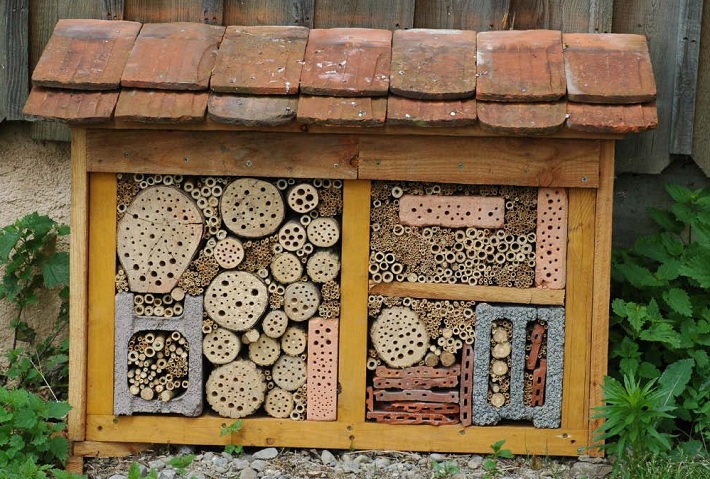
Solitary bees like sun. The ideal location for an insect hotel is in full sun and protected from the weather. This will ensure that the heat required for the brood is present, and wind or rain will not destroy their nest. Provide that, and the flowers, and they will come. www.sav-überlingen.de
Solitary bees are different from social bees (such as honey bees) in that every female is fertile and makes individual nest cells for her offspring. Some native bees are ground nesters but more than 30% are wood nesters. The female wood nester will look for pre-existing cavities such as hollow stems or holes in wood that are just the right size to use as a nest.
The female typically creates a series of compartments (cells) and within each cell she will lay an egg on top of its future food source. The female bee will make numerous trips to flowers collecting pollen and nectar that she will pack into each cell. On these trips, the female wild bee pollinates plants and food crops. It can take anywhere from 20 to 30 trips to fill each cell with food.
When she is satisfied with the amount of food, she lays an egg, compartmentalizes the cell, and moves on to creating the next cell. When she feels the chamber is complete, she seals off the end, and moves on to filling a new chamber. The last cells (those closer to the opening) contain eggs that will become males, as males hatch before females.
Although each species is different, mason bee females live for about a month, and can build a cell nest for about two eggs every day. The larva hatches from the egg after a week or more and begins to eat the provided pollen and nectar. After the food has been eaten, the larva spins a cocoon and pupates within the cell.
By the end of summer or early fall, the bee transforms but remains in the cocoon as an adult throughout the winter. In spring, the males begin to emerge by chewing their way out. The females, which are almost always in the deeper cells of the tunnel, emerge a week or two later.
While solitary females each make individual nests, some species prefer to make nests near others of the same species, giving the appearance to the casual observer that they are social. Nest photo by Mike N. of Vancouver, BC.
Bug hotel in Oakham, UK at the Lyndon Nature Reserve, built by Paul Stammers and Michelle Househam. Although often called a hotel, some bees will live in a nest for up to nine months as they develop from egg, through the larval stage, into adulthood. Photo by Anne Crasey, Flickr.
30 Amazing Insect Hotels Around The World
1) Insect Hotel In Germany
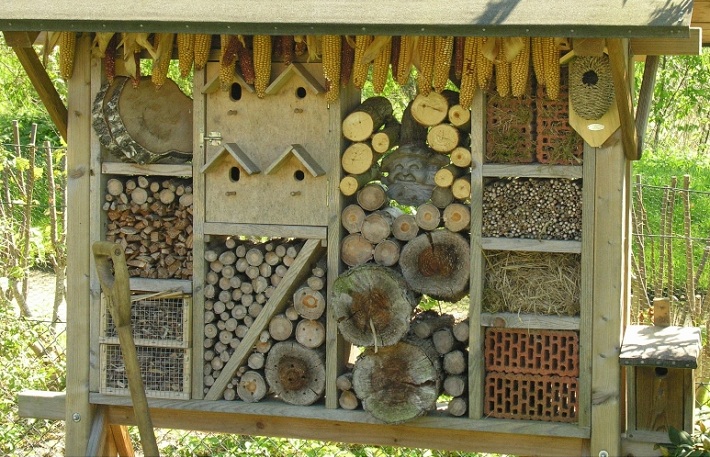
Insect hotel in Hamburg, Germany. Wild bee houses have been popular in Europe for many years. You can see more bee homes at insektenhotel24.de.
2) Solitary Bee Hotel

Insect hotel at the Heimanshof, North Holland. Many solitary bees are very small and you may not have realised they are bees. More species of bees live alone, than in hives. Wild bees are considered to be as important to the food chain as bumblebees and honeybees. Honey bees are not native to the Americas (see below). Photo by Bob Daamen, Flickr
Related Post: 18 Creative DIY Beehive Plans for Your Own Beekeeping
3) Oxburgh Hall Bug Bank

Insect home or bug bank, on the grounds of Oxburgh Hall in North Norfolk. Because solitary bees have no hive to defend, they are not aggressive, they rarely, if ever, sting. Photo by Mabvith, Flickr.
4) Bug Habitat Near Some Flowers

Insect hotel in Helmsley, UK. Hotels should be relatively close to flowering herbs, wild flowers and native shrubs and trees to cover the food needs of the insects. Photo by Munki Munki, Flickr.
5) Columnar Insect Condo
With this design, you can make the most of your space by increasing the surface area of a “smaller” sized hotel.
6) Bug Bank From Holland

Insect hotel in Hoofddorf, Holland. Drilled 4 x 4s, logs, twigs and sticks. There are many different species of solitary bee, all are excellent pollinators. Photo by Bob Daamen, Flickr
7) St. Poelten Landesmuseum’s Insect Hotel
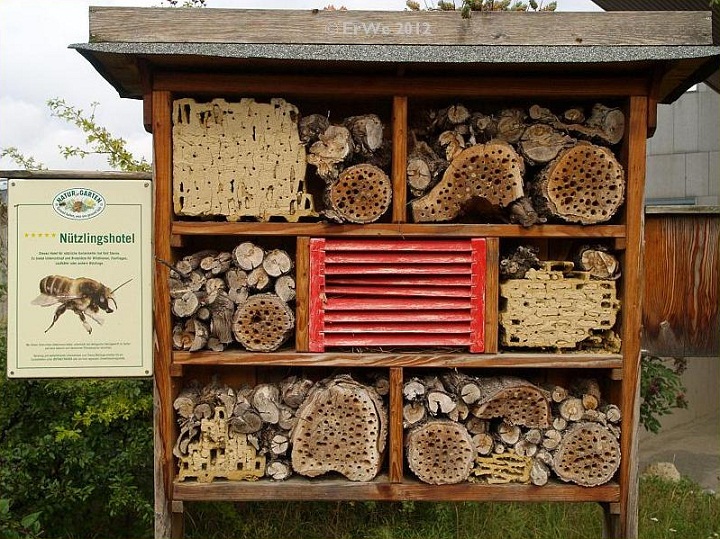
Insect hotel in St. Poelten Landesmuseum, Austria. That shutter will keep the birds out. Photo by Klasse im Garten, Flickr.
8) Bug Stack Mansion
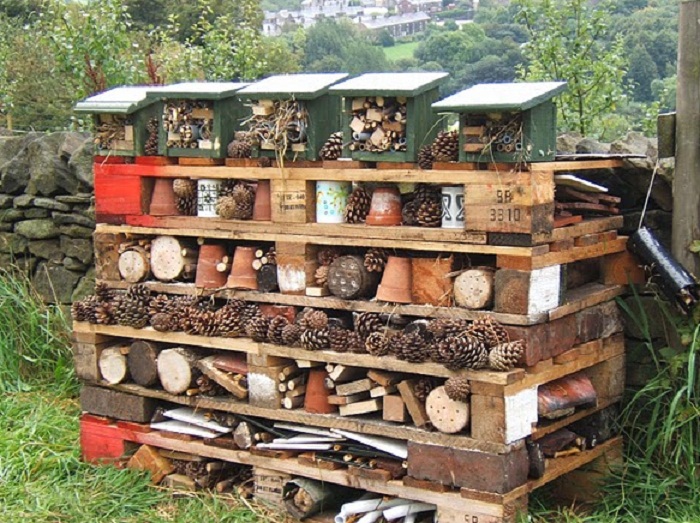
Bug stack. Keep an eye on activity as some ants will eat bee larvae. More on attracting insects to your garden can be found in the conversation held at sww.infojardin.com.
9) Simple Insect Habitat
Finding the resources for a bug hotel can be fairly easy because you don’t need to buy a lot of materials.
10) Bug Hotel For The Garden

Insect Hotel. Photo by Steve Leverett, FlickRiver.
11) Harrogate District Biodiversity Action Group’s Hotel

Bug Mansion. Ladybugs are always looking for places to hide and escape from the weather. By the Harrogate District Biodiversity Action Group. Flickr
12) Small Insect Stack

Wildlife stack by Dawn Isaacs. The plants on top of this insect hotel helps the structure blend into the garden. How-to: www.guardian.co.uk.
13) Bug Hotel In Scotland
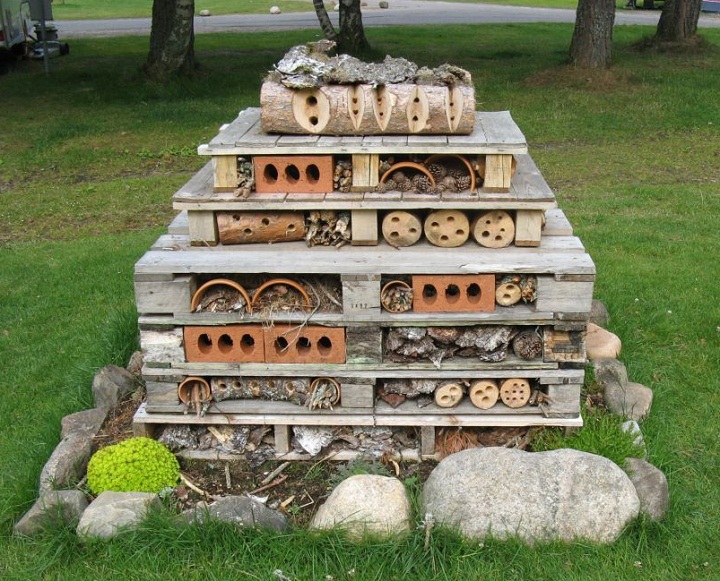
Insect Condo in Scotland. Don’t be discouraged if insects don’t immediately come to your insect hotel, it may take several months before they nest. Photo by Sheila, Flickr.
14) Bee Hotel From An Old Stump

Wild Bee Hotel in Austria. More information on this photograph can be found here on Flickr.
15) Wild Bee Condo

Bee Condo. Photo by Sissi de Kroon, Flickr.
16) Austrian Bug Bank

Insect Hotel in a private garden in Austria. This picture was found on www.klasse-im-garten.at, where you can discover even more ideas for your garden.
17) Hanging Insect Hotel

Insect Hotel, Ebersberger Forest, Bavaria. Photo by Terry Cooke, Flickr.
18) Relaxing Bug Habitat

Insect Hotel (Zen-like). Found on www.wildbienen.de, you can go to their page to find out more on wild bee conservation.
19) Bamboo Insect Hotel

Place cut bamboo in metal pipes. Photo by Bob Daamen. Flickr.
20) Protective Bug Bank

Wire screening keeps the small stuff in place and protects against birds. Photo by Joeke Pieters, Flickr.
21) Wild Bee Home
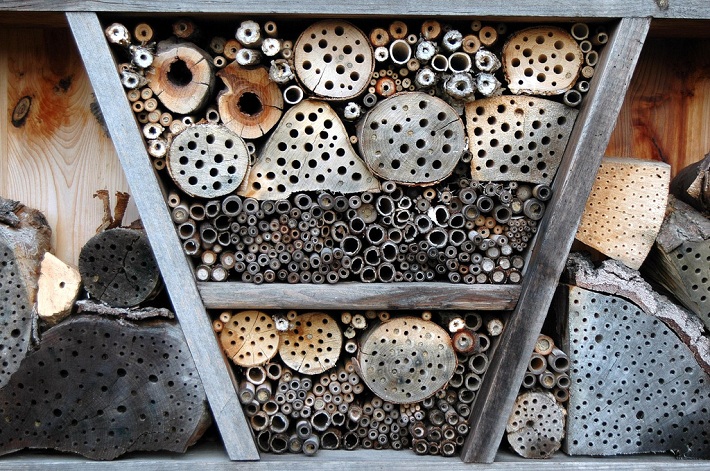
Wild bee house in the Black Forest, Germany. Photo by Michael Bohnert, Flickr.
22) Artistic Insect Home
This bug bank was designed for both function and appearance.
23) Demonstrative Bug Stack
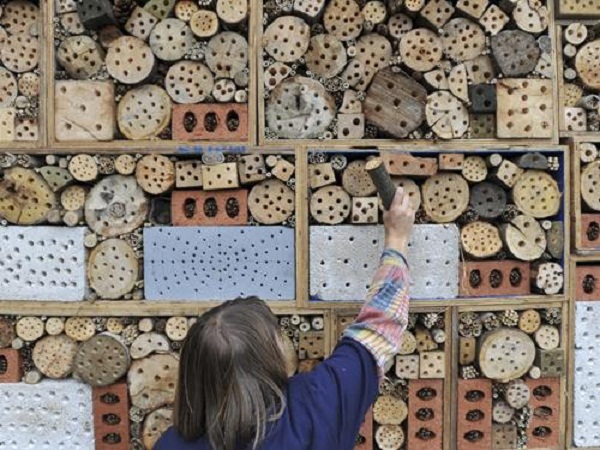
A fun learning project for kids.
24) Insect House From The Netherlands
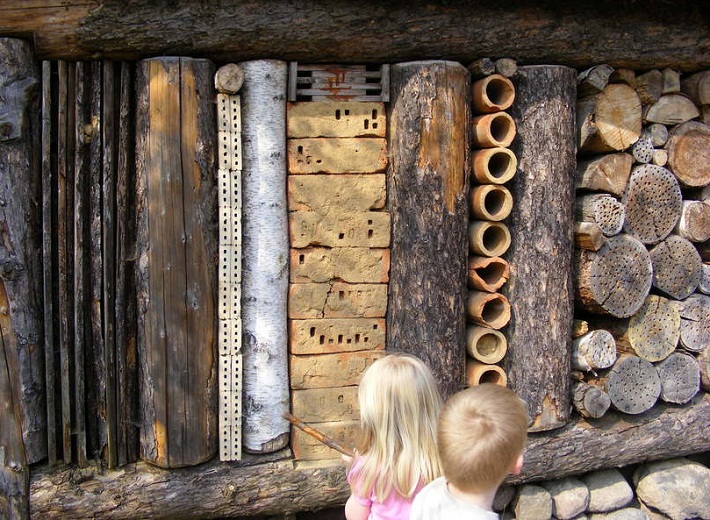
Insect hotel in the Netherlands, close-up. Found on Flickr.
25) Durrell Wildlife Conservation Trust’s Bug Bank
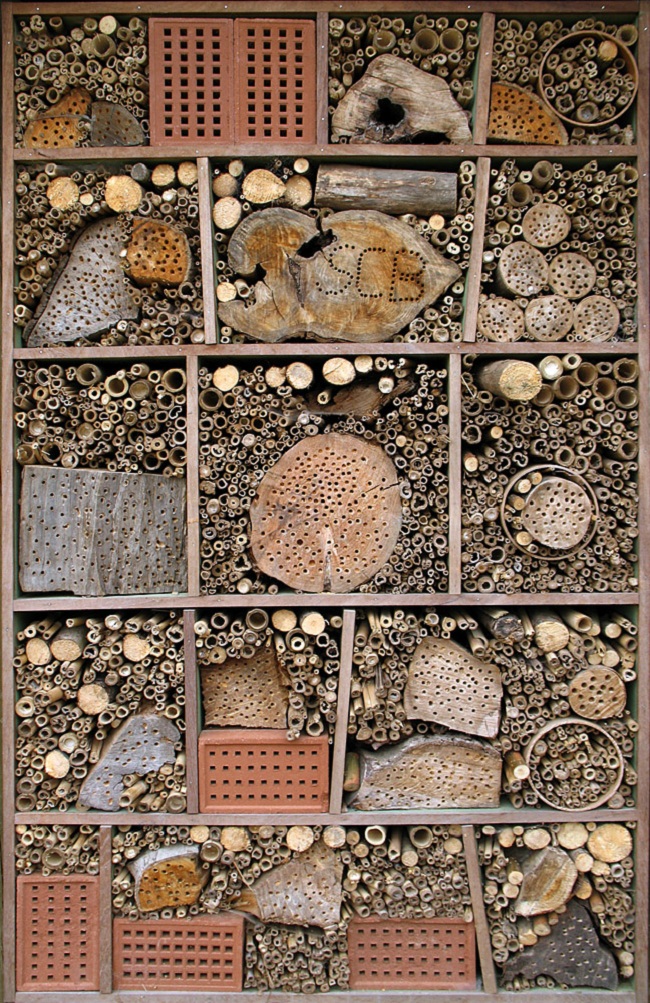
An ‘Insect hotel’ at the Durrell Wildlife Conservation Trust in Jersey ©RLLord, www.sustainableguernsey.info.
26) Bug Habitat
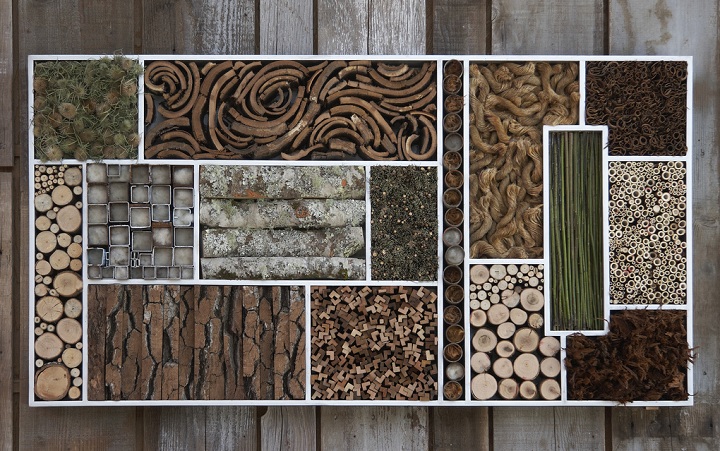
Insect Habitat assembled from foraged organic materials and reclaimed scrap, a habitat-in-waiting for bees and other native creatures. By Kevin Smith and Lisa Lee Benjamin. Originally found on floragrubb.com, you can find out more information at pithandvigor.com.
27) Red Insect Hotel

Insect Habitat at Garden Tulln, Austria. More information on this photograph can be found on Flickr here.
28) Bug Stack In Germany

Insect Hotel in Germany. This is another picture from the informational site www.wildbienen.de.
29) Living Willow Wales’ Insect Habitat
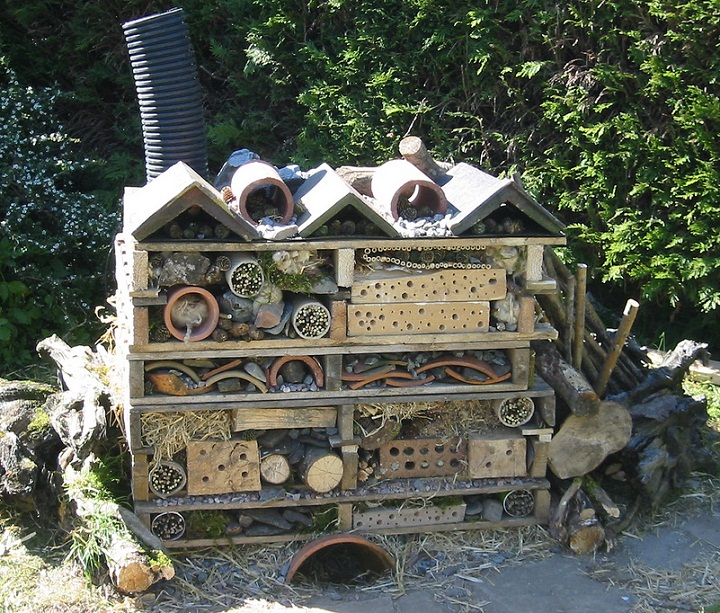
Bug hotel by Lisa and Andrew Roberts (Living Willow Wales) at Ysgol Pontrhydfendigaid. You can find this picture and instructions on andrewroberts.net.
30) Funky Bug Hotel

Bug hotel created by kids at the RHS Flower Show, Tatton Park. More information about this photograph can be found on Flickr.
Synonyms For Insect Hotel
Bug condos, bug hotels, insect habitats, wildlife stacks, insect boxes, insect houses, insect walls, wild bee walls, insect accommodation, wild bee houses, solitary bee walls or wild bienenhaus.
Who Lives In An Insect Hotel?
Wasps: cuckoo wasps, parasitic wasps and many more species…
Dragonflies, beetles, lacewings, ladybirds. moths, spiders, frogs, newts, hedgehogs, et al… www.wildbienenstand-neuhof.de
Bees: leafcutter bees, masked bees, mason bees, digger bees and hundreds more…
Bumblebees nest in hollow trees and in rodent burrows. They are among the first bees to emerge in the spring and the last to disappear in fall. They are superb pollinators of tomatoes, blueberries, cranberries, clover, and more. Bumblebees can “buzz pollinate” by hanging on a flower and vibrating with their flight muscles to release pollen.
Mason and Leafcutter Bees select existing hollow stems and bored holes in which to build their multiple nest chambers. They carry pollen underneath their bodies rather than on their legs like most bees, and the pollen falls off rather easily. Mason bees are first-class pollinators of many fruit crops, toiling long hours and in inclement weather. Squash and Gourd Bees help pollinate up to eighty percent of squash, pumpkins, and melons. They are ground nesters, so it is important to leave some open dirt for the these very important bees as well.
How To Build An Insect Hotel
- For a simple hotel, drill holes 1/4″ to 3/8″ in the ends of logs, or cut some bamboo sticks of equal length, and stuff in a wooden box.
- Layer old pallets.
- Logs, drift wood, cut bamboo, straw, dry reeds, roofing tiles, cob.
Do not use softwood for bees, as the drilled holes might fill with resin and suffocate the bees! Make sure all wood is free of chemical preservatives.
- www.foxleas.com/bee_house
- www.merthyr.gov.uk
- resonatingbodies.wordpress.com
- www.guardian.co.uk
- Building an insect habitat: cheshirewildlifetrust.org.uk
- Ulster Wildlife Trust, how to build an ‘insect hotel’ habitat.

Lots more inspiration here: flickr.com/groups/insecthotels
More Insect Hotel Info
- Lots of info here (use Google Translate): de.wikipedia.org
- Creating a Bumble Bee Nest by the USDA: ars.usda.gov
- Farming Native Bees in Delaware: dda.delaware.gov
- Enhancing Habitat for Wild Bees: www.xerces.org
- Lots of answers to your Mason Bee questions: crownbees.com
The folks at Crown Bees say that drilled holes and bamboo are not the best for mason bees, since parasites or disease might also invade these homes. They say that mason bees prefer reeds or paper straws, which also allow you to observe the mason bee’s nest. Yet they say even the reeds might attract pests after three years. Crown Bees suggests that trays which are like a block of drilled wood that comes apart for cleaning are best.
Watch the tray video here:
Some suggest spraying your existing drill holes every couple of years with a 5-10% bleach solution to keep them free of disease. You might also wish to redrill the holes in case anything is stuck in there (after the bees are gone). Actually it would probably be best to have two sets of nesting blocks, after each washout, drill and store inside, and put out the alternating block.


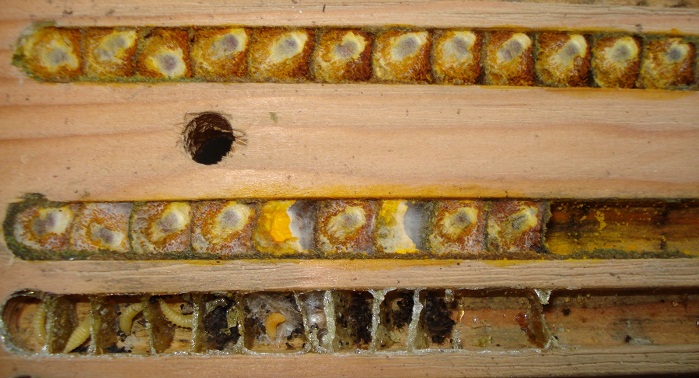
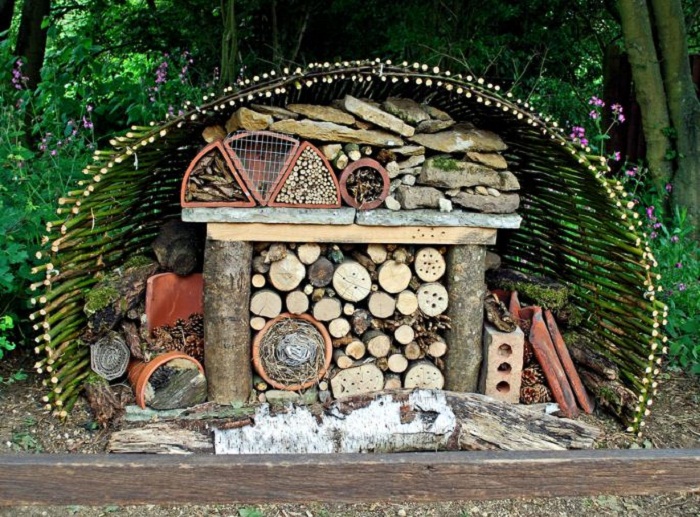








































I just want to let you know that I love this page….you do a great job. Thanks for posting!!
Oh these images are sensational! I really want to make one of these one day! Thanks for sharing 🙂 Karen (flightsofwhimsy-ece.com)
I am really inspired now. I have been looking at the possibility of getting some mason bees for several years and now I am inspired to make a beautiful house. Do these bees sting? Do they live compatibly with each other? What is the best kind for Northern Ca? Do I really need to buy some or will they just come naturally if I build a house?
Hi,
I have read that mason bees are gentle and will only sting if they are seriously threatened. Mason Bees are a small dark blue and gold bee that are excellent pollinators. They do not make nesting holes themselves, and will potentially lay fewer eggs if they can’t find adequate housing. They like smooth 5/16” holes. I have read that it is not good to buy bees, because you might introduce foreign pathogens into the local population. It is best to try to attract the locals. There is a great how to attract bees brochure/link – at the bottom of this page – https://lifecyclesproject.ca/resources/bee_average/bee_box.php
of insect hotels. Thank you for taking the time to put it together for us, and for including some of those I’ve found during my garden excursions.
Brigitte
Parabéns pelo site e pelo belo trabalho de divulgação das abelhas…
Sou do Brasil,e crio abelhas e amo esses seres maravilhosos…
Abraço.
Paulo Romero.
Meliponário Braz.
http://www.urucueabelhasnativas.blogspot.com
for my Brother and other earth friendly Critters….
Hi,
I really like the site and liked the bee house idea so much, that I made my own. Turne out pretty nice.
Just collected some giveaway pallets from a local garden centre and found this site to be truly inspirational. Can’t wait to start collecting stuff for the hotel! I had intended to position it under a hedge at the top of my allotment, but as it seems to be better in a sunny position, I will have to rethink.
Thank you so much for this amazing site! Many blessings 🙂
I love all these great ideas & pictures!! I knew there was a good use for all the stuff I’ve been collecting 😉
Love the blog- our website is set up for citizen scientists who are interested in creating wildlife habitats such as these! We give detailed plans and a place to submit data for all of the solitayr bee and wasp enthusiasts out there! Join us at http://www.ufnativebuzz.com and/or http://www.facebook.com/NBNSProject
Wow! The best collection of pics and ideas for Insect Hotels I’ve seen. Found it just now when a gardening acquaintance asked what the heck mine were for lol. Mine are just little ones inside bits of PVC pipe using bamboo, curled bark and straws to fill. I would so love to have one of these big ones. A real work of useful art. Thank you!
Great ideas! Just one correction though, before honeybees were introduced into the Americas, there WERE social bees present including numerous bumblebee species, several sweat bees, and even honey producing stingless bees South of the border.
Hi, You are right, that there were many types of bees in the Americas before the honeybee was introduced. I used the word social, but should change that to complex social to define honey, as there are semi-social and eusocial as well. Thanks. Just easier to say honeybees.
Hey, even I could build one of those. It’s going to be high on my list for the garden. I’ve been wanting a way to shelter my mason bees and these ideas are perfect. Thanks for pulling all these pix together in one place for inspiration.
Desde Barcelona, gracias por estas fotos tan estupendas !!! Los insectos de mi huerto tendrán un refugio.
All the photos are from places with good rain. I live in a desert alpine valley at 2000 meters. Would our insect hotels look the same here, or should there be provision for holding water nearby?
The insect hotel at Oakham is situated on The Lyndon Nature Reserve and was built by myself and Michelle Househam.The Lyndon Reserve is the home for a pair of breeding Ospreys we also have four wild flower meadows. you can track the progress of the ospreys on http://www.ospreys.org
Thanks Paul Stammers
Definitley going to build a small hotel in my yard! I had never thought of this. However, the paper wasps and honeybees are so docile around my porch, that I can easily handle them gently. So far no Africanized bees…..
What about rats? is a question I anticipate.
Your answer is ?
Thanks, Ted, Plan Bee Now! Duncan, BC, Canada
But do they work? Lots of info in this Pacific Horticulture article and the online supplement: https://www.pacifichorticulture.org/articles/insect-hotels/
Wow! Once built do you leave the condos alone? What maintnance is required – especialy for mason bees?
Yes, for mason bees you must do a bit of maintenance as they are more susceptible to disease. Lots of answers to your Mason Bee questions at: crownbees.com
They suggest that drilled holes and bamboo are not the best for mason bees after just one or two seasons, for parasites or disease might also invade these homes. They state that mason bees prefer reeds or paper straws, these also allow you to observe the mason bee’s nest. Yet they say even the reeds might attract pests after three years. The company Crown Bees suggest that trays which are like a block of drilled wood that comes apart for cleaning are best. See those on their site… Hope your bee tending is a success. Best, K
70% of native bee species are ground nesters. The insect hotel is fabulous and I see it provide nest habitat for wood tunnel aand stem nesting bees and wasps as well as nesting places for different species of bumblebees. BUT how are most of the native bees that nest in the ground accomodated in the gardens where these insect hotels are located? Thanks for your answer. All Good Stuff! Ted Leischner, Pollinator Conseervation and Habitat Restoration Specialist, Plan Bee Now!, Duncan, BC, Canada
What an inspirational collection of photos…and the information is great, too. Thanks for sharing!!!
How does this work? How will you attract insects to live there?
I love these insect preserving ideas. Are you aware that your site has an ad for Terminix on it? Perhaps an insecticide ad is not the best choice! Thanks
Thank you !
Hello,
interesting and useful idea!
Just a small question: do you know about any studies regarding the interaction between the different types of insects hosted by the various materials and hole diameters ?
whats the best way to get the bees to come
This is a nice way to keep both the wildlife and the gardener happy. Time to learn to live in harmony with nature instead of trying to bring it to its knees all the time.
Loved all the photos giving me great ideas on getting started with my bug house! So much cheaper than buying one pre-made. The joy is in the doing. Question: How deep should the materials be and how deep to drill the holes?
thank you for this beatiful information
thank you for this beatiful information
Hi,your design of insect house very cute.
If need producing, we think we can cooperation with you !
Hi I really like some of these adventurous & fun designs!!Great way to publicise solitary bees.
I design nest boxes and you may like to see a different prospective- education! examples can be found at Nurturing Nature UK
This is one of the coolest things I’ve ever seen!!
Love your post, but please people, lets stop calling any structures we make or bees and other insects ‘hotels’. ‘Hotel’ implies that they check in and out – temporary. Mostly they will use anything we build to propagate the next generation therefore I much prefer bee homes, insect homes, bug homes …
Thank you for this page.
Wonderful inspiration for me and great links to even more information.
I’m going to be busy like a bee 😉 this spring building for my insect friends.
Hartelijk dank voor deze geweldige foto’s en ideeën!
Beautiful collection of bee houses or even towns. Some of them are so big! Are there any estimates about the habitat and flower resources needed to sustain such large populations of bees? I wonder.
My name is Sean and I would like you to add our website to the links on your site please. Our site address is http://www.schoolbughotel.weebly.com
We built a bug hotel in our school and we have lots of information about the hotel on our site. We will add a link to your site today.
Wouldn’t these also harbor a lot of earwigs?
Thank you for sharing this very useful information with us 🙂
potato
omg that is awesome I like it uh uh uh uh uh uh uh
This is one of the coolest things I’ve ever seen!!
albaraak. com
So excited and now motivated after seeing these brilliant creations. How excellent are these structures. Thanks so much for sharing this.
Theya re adorable. Sharing on my FB page.